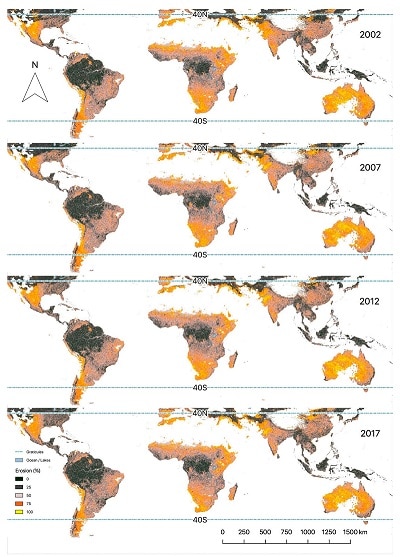Mapping Soil Erosion using Satellite Remote Sensing

Predicted probabilities of soil erosion for Karnataka, India for 2002, 2007, 2012, and 2017 (Figure 9).
Abstract
Soil erosion has long been recognized as a major process of land degradation globally, affecting millions of hectares of land in the tropics and resulting in losses in productivity and biodiversity, decreased resilience of both marine and terrestrial ecosystems, and increased vulnerability to climate change. This paper presents an assessment of the extent of soil erosion in the global tropics at a moderate spatial resolution (500 m) based on a combination of systematic field surveys using the Land Degradation Surveillance Framework (LDSF) methodology and Earth observation data from the Moderate Resolution Imaging Spectroradiometer (MODIS) platform. The highest erosion prevalence was observed in wooded grassland, bushland, and shrubland systems in semi-arid areas, while the lowest occurrence was observed in forests. Observed erosion decreased with increasing fractional vegetation cover, but with high rates of erosion even at 50–60% fractional cover. These findings indicate that methods to assess soil erosion need to be able to detect erosion under relatively dense vegetation cover. Model performance was good for prediction of erosion based on MODIS, with high accuracy (~89% for detection) and high overall precision (AUC = 0.97). The spatial predictions from this study will allow for better targeting of interventions to restore degraded land and are also important for assessing the dynamics of land health indicators such as soil organic carbon. Given the importance of soil erosion for land degradation and that the methodology gives robust results that can be rapidly replicated at scale, we would argue that soil erosion should be included as a key indicator in international conventions such as the United Nations Convention to Combat Desertification.
Vågen, Tor-Gunnar, and Leigh Ann Winowiecki. “Predicting the Spatial Distribution and Severity of Soil Erosion in the Global Tropics using Satellite Remote Sensing.” Remote Sensing 11, no. 15 (2019): 1800.
September 18, 2019
CGIAR-CSI





